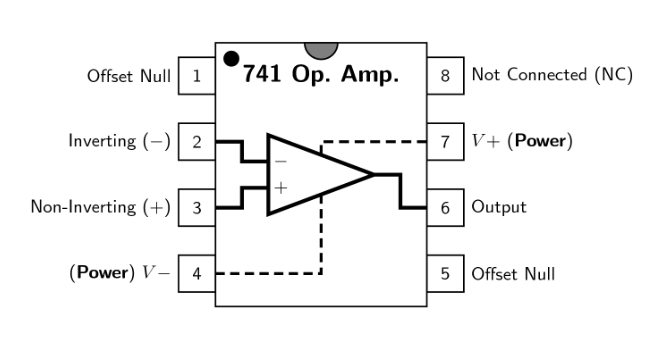
An ideal Op-amp is an ideal
A) Current controlled current source
B) Current controlled Voltage source
C) Voltage controlled Voltage source
D) Voltage controlled current source
Answer
568.8k+ views
Hint:The Operational Amplifier has many types of filters (low-pass, high-pass, band-passing, buffer, invert, non-invert, differential, summative and instrumental), oscillator, band-passes, sources (voltage, current), voltage-to-current (current, current-to - voltage) and other non-linear applications.
Step by Step Solution:
An ideal op amplifier is an op amp that has reasonable conditions for it to function as a 100% effective op-amp. An optimum op amp shows the following functions, all of which are detailed below. Ideal op-amps have an infinite voltage gain, infinitely high impedance, zero output impedance, their gain is independent of the input frequency, they have null voltage offset, and their output will swing positive or negative at the same voltage as the power rail and their output fluctuates immediately at the right level.
The perfect op amp has a current of zero input. This is due to infinite resistance of the input. Since the input resistance is infinite, there is an open circuit at the input, which means that a current at all input terminals is zero.
Therefore,

In the above given diagram, it can be seen that there is no current through the input resistance, therefore considering,
${v_1} = $ Inverting voltage
${v_2} = $ Non – Inverting Voltage
In case of an ideal operational amplifier,
${v_1} = {v_2} $or
${v_1} - {v_2} = 0$
Since there is no current through the input resistance, therefore, there will be no voltage drop across the input terminals.
Therefore, an ideal operational amplifier is an ideal voltage controlled voltage source or option C
Note: There are also limitless bandwidths to run an optimal operational amplifier. This means that the operational amplifier works for all frequency ranges.
Step by Step Solution:
An ideal op amplifier is an op amp that has reasonable conditions for it to function as a 100% effective op-amp. An optimum op amp shows the following functions, all of which are detailed below. Ideal op-amps have an infinite voltage gain, infinitely high impedance, zero output impedance, their gain is independent of the input frequency, they have null voltage offset, and their output will swing positive or negative at the same voltage as the power rail and their output fluctuates immediately at the right level.
The perfect op amp has a current of zero input. This is due to infinite resistance of the input. Since the input resistance is infinite, there is an open circuit at the input, which means that a current at all input terminals is zero.
Therefore,

In the above given diagram, it can be seen that there is no current through the input resistance, therefore considering,
${v_1} = $ Inverting voltage
${v_2} = $ Non – Inverting Voltage
In case of an ideal operational amplifier,
${v_1} = {v_2} $or
${v_1} - {v_2} = 0$
Since there is no current through the input resistance, therefore, there will be no voltage drop across the input terminals.
Therefore, an ideal operational amplifier is an ideal voltage controlled voltage source or option C
Note: There are also limitless bandwidths to run an optimal operational amplifier. This means that the operational amplifier works for all frequency ranges.
Recently Updated Pages
A man running at a speed 5 ms is viewed in the side class 12 physics CBSE

The number of solutions in x in 02pi for which sqrt class 12 maths CBSE

State and explain Hardy Weinbergs Principle class 12 biology CBSE

Write any two methods of preparation of phenol Give class 12 chemistry CBSE

Which of the following statements is wrong a Amnion class 12 biology CBSE

Differentiate between action potential and resting class 12 biology CBSE

Trending doubts
What are the major means of transport Explain each class 12 social science CBSE

Draw ray diagrams each showing i myopic eye and ii class 12 physics CBSE

Draw a ray diagram of compound microscope when the class 12 physics CBSE

Give simple chemical tests to distinguish between the class 12 chemistry CBSE

Using Huygens wave theory derive Snells law of ref class 12 physics CBSE

Dihybrid cross is made between RRYY yellow round seed class 12 biology CBSE




